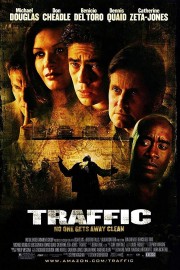Traffic
I remember watching Steven Soderbergh’s “Traffic” when it opened in Atlanta in 2001, and I had the thought a lot of people did after seeing it- that it was a hard-hitting look at the many facets, and many fronts, of the “War on Drugs.” Watching it nearly two decades later, Soderbergh’s Oscar-winning film remains a terrific cinematic accomplishment, and a fascinating example of Soderbergh expanding his storytelling pallet, the Stephen Gaghan screenplay is really pulpy and melodramatic. That’s part of why it plays so well, though, and Soderbergh still has some interesting things to say.
When we think on America’s War on Drugs, we think of the border between us and Mexico, we think of the Reagan administration and political optics, and we think of how a large portion of non-violent people of color have been unfairly imprisoned for ridiculous amounts of time. There is more, of course, but by and large, the war is painted in broad strokes that don’t really get to the reality of what it entails, and what it costs. That is what Soderbergh and Gaghan, whom both won Oscars for this film, is trying to get at, and how the platitudes and broad strokes fail to illuminate the sad truth of the situation for those closest to it…that our “War on Drugs” is lost for too many people. The way we approach it is good optics, but a failure to address major issues with regards to addiction, the violence it brings, and how people get caught up in it. As pulpy as “Traffic” is, we get this look in a way that is effective and accessible.
This marked the first time that Soderbergh acted as his own cinematographer, and it is an important decision. He had a distinct vision of what he wanted this film to be like, and how he wanted to bring us into these stories emotionally, and he had learned a lot in the decade-plus since “sex, lies and videotape” to give him the moxie to make the move. It’s a choice that has paid dividends since; imagine the “Ocean’s” films or “Solaris” shot any other way. In “Traffic,” he uses filters to distinguish between locations and storylines, and give us an emotional barometer for each story. This was hailed for its ingenuity at the time, but it really plays into the melodrama now, even if I cannot imagine the film done any other way. The blue hues of Roger Wakefield’s narrative, as the Ohio State Judge takes a job as Washington’s drug czar, only to find himself embroiled in the drug war at home with his daughter, give us a sense of sadness and melancholy about how one person’s crusade can seem futile when his own life is impacted. On the Mexican side, bleached out yellow hues make Tiujana cop Javier’s attempts to stay on the right side of the law when everything around him points to the criminal side not only being more profitable, but also, maybe saving your life, feel as punishing as the desert sun. On the border, DEA agents trying to take down American traffickers and distributors through the justice system are treated to a typical color pallet; of the three major storylines, this one makes the most sense for that choice, because it’s how we would typically experience this type of story, with crisp colors and sensationalism on the news cycle as a young wife has her life turned upside down by her husband’s arrest.
As Javier, Benicio Del Toro is the standout of the big cast; he won an Oscar for his role, which is mostly in Spanish, and I was drawn in yet again rewatching the film for this review. The actor just has a presence that we’re engaged by as he builds characters, whether they’re grounded like Javier or a bit outrageous like his Collector in the Marvel Cinematic Universe or DJ in “The Last Jedi.” I think the next performance that resonated with me on this viewing as Catherine Zeta-Jones as Helena Ayala, the wife whose husband has been arrested. At first, she is oblivious to her husband’s dealings, but when she finds herself facing the ugly side of the business, she starts to prove herself more than adept in that world; Zeta-Jones is great at playing both the vulnerable and tough-minded sides of the character. As for the story with the most emotional heft, that being Roger Wakefield (Michael Douglas) and his wife (Amy Irving) and their struggles with their free-basing daughter (Erika Christensen), this is where the melodramatic side of the film really kicks in. If “Requiem for a Dream” hadn’t come out the same year, and presented the most harrowing version of drug addiction we’ve ever seen on film, this part might have had real weight, but this is where the most simplistic arguments in Gaghan’s screenplay come out, and it is wrapped up in such a pat and facile way that it’s hard to get invested in this side the way it wants us to, even with good work by everyone involved.
“Traffic” is still one of the best films Soderbergh has ever made, however; it was the kickoff of another chapter of his career that was all about experimenting with narrative and cinematic slight of hand, visually pushing himself, and building a career within the studio system. This was an independent film, but it was also a big hit, and, coupled with his other Best Picture nominee that year (“Erin Brockovich”), made him a filmmaker studios weren’t afraid to ride with, even when he got a bit weird. In “Traffic,” he’s walking a tightrope between star vehicles and inventive storytelling, and he succeeds in a big way, even if it doesn’t play as dramatically as it used to.










